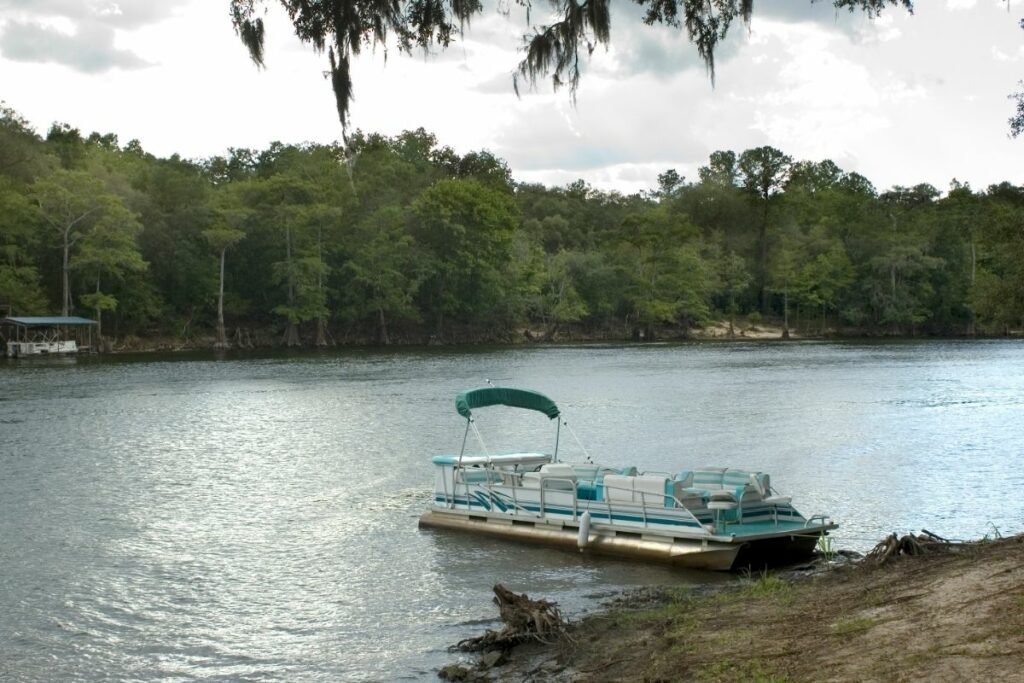Pontoon boats are those kinds of boats that have two or more cylindrical bodies as hulls on which the decks are appended to.
The cylindrical bodies provide the buoyant forces to keep the body floating and since the deck is attached to two or more hulls it brings forward good stability in terms of anti-rolling characteristics.
The main advantage of pontoons is that they have a wide deck space that can be used for unlimited possibilities. They are used in various leisure and commercial activities in both fresh and saltwater.

Now the question emerges why are lift strakes utilized on Pontoons? Because of its tube-shaped curved surfaces, it is hard for lift forces to act upon these surfaces making the hull dig through the water, so lifting strakes provide a flatter surface that can assist the hull by giving more lift so the hull can ride on top of the water, consequently bringing down the drag forces, increasing speed and expanding fuel economy.
So, what are Lifting strakes made of? how do they affect the overall performance of the hull? how are they installed? Are they worth it? Let’s get into more details and find out.
What are Lifting Strakes?
Lifting strakes are designed to have a triangular cross-section with its bottom surface always parallel to the water surface. They run longitudinally along the length of the hull and are equally placed on both sides of the hull from the centerline.
Lifting strakes may either run throughout the length of the hull or even partially so as to provide lift in specific areas. The corner of the stakes is made sharp and not rounded so as to provide efficient water detachment from the lift surfaces.
They are usually made up of the same material the hull is made from which is normally steel, Aluminum, or composite.
Effects On Hull: How Do Pontoon Lift Strakes Work?
The strakes provide a better lift for the hull thereby reducing the resulting hydrodynamic drag forces caused by the submerged area in contact with the water surface.
An overall increment of 15-25% in speeds can be observed from well-designed and properly positioned lifting strakes. As the speeds increase this gives the owner the opportunity to cruise at higher speeds thereby increasing the fuel economy which can save costs in the long run.
On the contrary, strakes positioned on the forward part of the hull can lead to riding discomfort during events of slamming at higher speeds and rougher waters, as the flat sections of the strakes prevent ease of penetration of the hull surface inside the water bringing forward a feeling of discomfort during events of slamming. They can also affect the maneuvering characteristics of the hull at higher speeds.
How Are Lifting Strakes Different From Spray Rails?
Lifting strakes are different from spray rails as lift strakes are provided so as to increase the overall lift forces acting on the hull whereas spray rails are designed to deflect the spray caused by the hulls planning on water, which can wet a significant part of the hull and act as a drag force at high speeds.
Also, lifting strakes can also produce some spray while it provides lift forces.
How To Install Lifting Strakes
Lifting strakes come as a standard or can be added to the hull surface depending on the type of materials used to build the hull.
If the hulls are made out of steel/Aluminum the strakes are fabricated separately and welded onto the bottom surface and if the hulls are made out of composite they are normally designed in the mold or can be bonded to the hull bottom at any desired time.
Care should be taken while bonding to hulls, making sure to prepare the hull surface so as to provide sufficient mechanical bonding.
Are Pontoon Lifting Strakes Worth The Money?
Yes, a well-designed strake is definitely worth the money considering the savings on fuel prices in the long term and also the ease of installation which can be done by self.
Knowing the right dimensions of the strakes and the position where they are supposed to be installed and the right installation methods or an easier way is to get it done in any local boatyards nearby.
Compared to other methods to increase speed like an engine upgrade or trimming down weights from the boat, which can be way more expensive and reduce the functionality of the boat in terms of storage and so on.
Installation costs can vary for different boats depending on the hull length, the number of lifting strakes, and the material that is used to make the strakes.
Final Thoughts:
Lifting strakes can be an easy upgrade to your pontoons which can easily make you enjoy the new high-end speeds of your boat and also cut costs in the long run, in terms of fuel prices along with lesser emissions to the environment and hassle-free maintenance.
Again, it’s the sole choice of the owner if he needs that extra speed and fuel-saving based on how frequently he goes out in the water.
- Types of Gas Carriers as per IGC Code – April 22, 2025
- Wind-Assisted Propulsion Systems (WAPS): A Game Changer for Maritime Decarbonization – February 6, 2025
- 10 Boat Salvage Yards in California – January 25, 2025




